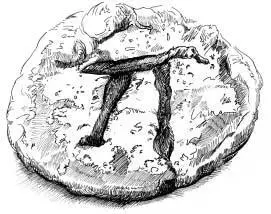Much of the paper consisted of legal pads covered with Gregory’s handwriting. His handwriting was dense and careful, a flawless minuscule written with a felt-tipped pen. The writing contained a mixture of theorems, calculations, proofs, and conjectures concerning numbers. He used a felt-tip pen because he didn’t have enough strength in his hand to press a pencil on paper. Mathematicians who had visited Gregory Chudnovsky’s bedroom had come away dizzy, wondering what secrets the scriptorium might hold. He cautiously referred to the steamer trunks beneath the window as valises. They were filled to the lids with compressed paper. When Gregory and David flew to Europe to speak at conferences on the subject of numbers, they took both “valises” with them, in case they needed to refer to a proof or a theorem. Their baggage particularly annoyed Belgian officials. “The Belgians were always fining us for being overweight,” Gregory said.
The brothers’ mail-order supercomputer made their lives more convenient. It performed inhumanly difficult algebra, finding roots of gigantic systems of equations, and it constructed colored images of the interior of Gregory Chudnovsky’s body. They used the supercomputer to analyze and predict fluctuations in the stock market. They had been working with a well-known Wall Street investor named John Mulheren, helping him get a profitable edge in computerized trades on the stock market. One day I called John Mulheren to find out what the brothers had been doing for him. “Gregory and David have certainly made us money,” Mulheren said, but he wouldn’t give any details on what the brothers had done. Mulheren had been paying the Chudnovskys out of his trading profits; they used the money to help fund their research into numbers. To them, numbers were more beautiful, more nearly perfect, possibly more complicated, and arguably more real than anything in the world of physical matter.
* * *
THE NUMBER PI, or π, is the most famous ratio in mathematics. It is also one of the most ancient numbers known to humanity. Nobody knows when pi first came to the awareness of the human species. Pi may very well have been known to the builders of Stonehenge, around 2,600 B.C.E. Certainly it was known to the ancient Egyptians. Pi is approximately 3.14—it is the number of times that a circle’s diameter will fit around a circle. On the following page is a circle with its diameter.

Landscape with a circle and its diameter. This drawing shows a rough visual approximation of pi.
Drawing by Richard Preston
Pi is an exact number; there is only one pi. Even so, pi cannot be expressed exactly using any finite string of digits. If you try to calculate pi exactly, you get a chain of random-looking digits that never ends. Pi goes on forever, and can’t be calculated to perfect precision: 3.1415926535897932384626433832795028841971693993751…. This is known as the decimal expansion of pi. It is a bloody mess. If you try to express pi in another way, using an algebraic equation rather than digits, the equation goes on forever. There is no way to show pi using digits or an equation that doesn’t get lost in the sands of infinity. Pi can’t be shown completely or exactly in any finite form of mathematical representation. There is only one way to show pi exactly, and that is with a symbol. See the illustration on the following page for a symbol for pi.
The pizza pi I baked and drew, here, is as good a symbol for pi as any other. (It tasted good, too.) The digits of pi march to infinity in a predestined yet unfathomable code. When you calculate pi, its digits appear, one by one, endlessly, while no apparent pattern emerges in the succession of digits. They never repeat periodically. They seem to pop up by blind chance, lacking any perceivable order, rule, reason, or design—“random” integers, ad infinitum. If a deep and beautiful design hides in the digits of pi, no one knows what it is, and no one has ever caught a glimpse of the pattern by staring at the digits. There is certainly a design in pi, no doubt about it. It is also almost certain that the human mind is not equipped to see that design. Among mathematicians, there is a feeling that it may never be possible for an inhabitant of our universe to discover the system in the digits of pi. But for the present, if you want to attempt it, you need a supercomputer to probe the endless sea of pi.

Pi.
Drawing by Richard Preston
Before the Chudnovsky brothers built m zero, Gregory had to derive pi over the Internet while lying in bed. It was inconvenient. The work typically went like this:
Tapping at a small wireless keyboard, which he places on the blankets of his bed, he stares at a computer display screen on one of the bookshelves beside his bed.
The keyboard and screen are connected through cyberspace into the heart of a Cray supercomputer at the Minnesota Supercomputer Center, in Minneapolis. He calls up the Cray through the Internet. When the Cray answers, he sends into the Cray a little software program that he has written. This program—just a few lines of code—tells the supercomputer to start making an approximation of pi. The job begins to run. The Cray starts trying to estimate the number of times the diameter of a circle goes around the periphery.
While this is happening, Gregory sits back on his pillows and waits. He watches messages from the Cray flow across his display screen. The supercomputer is estimating pi. He gets hungry and wanders into the dining room to eat dinner with his wife and his mother. An hour or so later, back in bed, he takes up a legal pad and a red felt-tip pen and plays around with number theory, trying to discover hidden properties of numbers. All the while, the Cray in Minneapolis has been trying to get closer to pi at a rate of a hundred million operations per second. Midnight arrives. Gregory dozes beside his computer screen. Once in a while, he taps on the keys, asking the Cray how things are going. The Cray replies that the job is still active. The night passes and dawn comes near, and the Cray is still running deep toward pi. Unfortunately, since the exact ratio of the circle’s circumference to its diameter dwells at infinity, the Cray has not even begun to pinpoint pi. Abruptly, a message appears on Gregory’s screen: LINE IS DISCONNECTED.
“What’s going on?” Gregory exclaims.
Moments later, his telephone rings. It’s a guy in Minneapolis who’s working the night shift as the system operator of the Cray. He’s furious. “What the hell did you do? You’ve crashed the Cray! We’re down!”
Once again, pi has demonstrated its ability to give the most powerful computers a heart attack.
* * *
PI WAS BY NO MEANS the only unexplored number in the Chudnovskys’ inventory, but it was one that interested them. They wondered whether the digits contained a hidden rule, an as yet unseen architecture, close to the mind of God. A subtle and fantastic order might appear in the digits of pi way out there somewhere; no one knew. No one had ever proved, for example, that pi did not turn into a string of nines and zeros, spattered in some peculiar arrangement. It could be any sort of arrangement, just so long as it didn’t repeat periodically; for it has been proven that pi never repeats periodically. Pi could, however, conceivably start doing something like this: 122333444455555666666…. That is, the digits might suddenly shift into a strong pattern. Such a pattern is very regular, but it doesn’t repeat periodically. (Mathematicians felt it was very unlikely that pi would ever become obviously regular in some way, but no one had been able to prove that it didn’t. )
Читать дальше










![Shin_Stark - В подземелье я пойду, там свой level подниму X [СИ]](/books/384602/shin-stark-v-podzemele-ya-pojdu-tam-svoj-level-po-thumb.webp)



